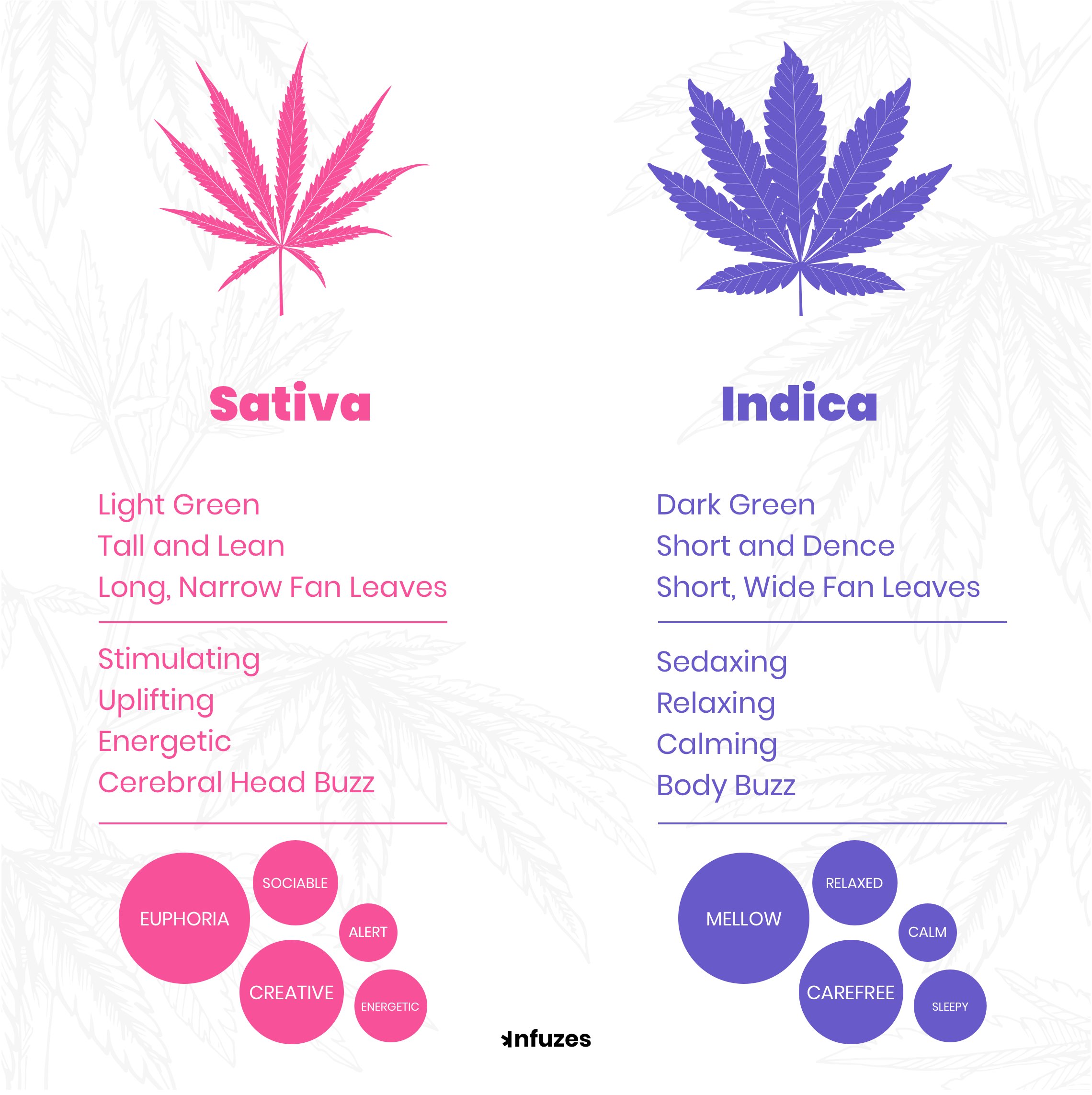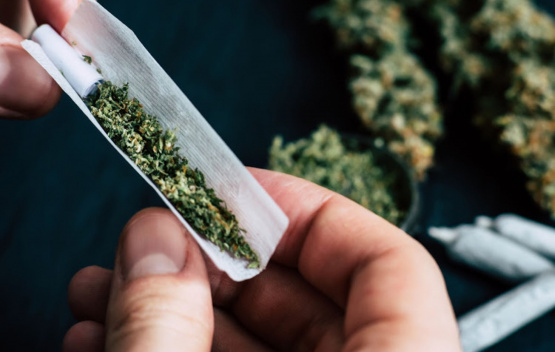If you are newbie to cannabis and just starting to explore the market, the first thing you learn is that all strains are generally divided into 2 main groups: Indica and Sativa. Such a division may be justified by the expected effects after usage.
It is believed that Indicas bring a sedative effect accompanied by a physical relaxation. Sativa strains will influence you in the opposite way. Most cannabis users will hear the term Sativa and think of an energizing, uplifting, and cerebral experience.
The belief that different types of cannabis provide different specific effects is widespread not only among consumers, but among budtenders as well.
However, cannabis studies do not confirm this stereotype. Scientists have found that there are no sufficient grounds to assert that Indicas and Sativas exhibit a consistent pattern of chemical profiles that would make one inherently sedating and the other uplifting. It is well known that Indica and Sativa look different, grow in different ways and under different climatic conditions, but such characteristics will be more useful for plants cultivators than for consumers.

The question arises, what were the reasons for such a firm rooting of these two notions in the cannabis community, where did the terms Indica and Sativa came from and whether one should take them into account when choosing a strain?
Indica and Sativa: History of Terms
Swedish botanist Carl Linnaeus ascribed the name C. sativa to what he considered the only species of the genus Cannabis in 1753. Thirty-two years later, French Biologist Jean-Baptiste Lamarck identified Cannabis indica as a separate species from Cannabis sativa — arguably cementing the foundation of the current Sativa/Indica taxonomy.
Lamarck primarily based his C. indica classification on physical differences from Linnaeus’s C. sativa plant. He also noted that C. indica was a more potent inebriant than C. sativa, marking the earliest instance of relating the plant’s effects to its type.
Today, the “Sativa” label is reserved for plants that share common physical profiles. Most countries only recognize one species, Cannabis sativa, and it remains highly debated whether Indica is a subspecies. Meanwhile, the marketplace still recognizes two varieties, Sativa and Indica.
Human intervention has dramatically changed the chemical makeup of cannabis. In the days of Linnaeus and Lamarck, the effects of C. sativa and C. indica plants may have aligned more closely with their physical characteristics. Today, a plant’s appearance tells us nothing about what kind of effect it will produce.You may be puzzled by such confusion in taxonomic distinctions between cannabis species. The more important issue is not the distinction between types of cannabis, but the study of their practical value. To answer this question, we turned to famous researchers in this field.
Indica vs. Sativa Effects: Expert Commentary
We took the opinions of two prominent researchers if the Sativa/Indica classification should affect the consumer when choosing a strain.Ethan Russo is internationally renowned for his research on cannabis compounds and their roles in the body. As a neurologist and psychopharmacologist, Russo has established himself as a crucial champion of the integral roles plant-based medicine should play in modern therapeutics. After wrapping up a decade-plus run as Senior Medical Advisor for GW Pharmaceuticals in 2014, Russo co-founded PHYTECS, a biotechnology company devoted to researching and developing medical approaches to the human endocannabinoid system, for which Russo serves as Medical Director. (In his spare time, he hosts Reddit AMAs.)
"The way that the Sativa and Indica labels are utilized in commerce is nonsense. The clinical effects of the cannabis chemovar have nothing to do with whether the plant is tall and sparse vs. short and bushy, or whether the leaflets are narrow or broad."
Jeffrey Raber currently serves as the Executive Director of the Association of Commercial Cannabis Labs (ACCL). Driven by a desire to find his own medicine and make a positive contribution to society while creating American jobs, Dr. Raber founded The Werc Shop in 2010 with a focus on botanical analysis, new product developments and sustainability. The Werc Shop’s first goal was addressing unmet public health and safety needs within the medical cannabis community. Dr. Raber’s detailed investigations into the chemistry of cannabis, including 5 peer reviewed publications to date, provide him with a unique perspective and knowledge base useful in assisting state and local regulators in the construction and implementation of effective regulatory solutions for the safe and sustainable delivery of medical cannabis to qualified patients and adult consumers. Speaking about budtenders' advice to buy Indica or Sativa, Dr. Raber stressed the next: "There is no factual or scientific basis to making these broad sweeping recommendations, and it needs to stop today. What we need to seek to understand better is which standardized cannabis composition is causing which effects, when delivered in which fashions, at which specific dosages, to which types of [consumers]."
Summing up the experts' opinions, we can conclude that not all sativas will energize you, and not all indicas will sedate you. There’s no clear-cut rule and no determinant chemical data that provides a perfect predictive pattern.
Particular Strain For Particular Effect
The Indica/Sativa system we use to predict cannabis effects is no doubt convenient, especially when first entering the vast, overwhelming world of cannabis. But keep in mind, that the effects of any given cannabis strain depend on a number of different factors, including your unique biology and tolerance, dose, and consumption method. Compare your personal experience to all these factors and you will find what strain suits for you in the best way.
The many different varieties of cannabis contain hundreds of compounds, each with its own characteristics and properties. You’ll most likely have heard of cannabinoids and terpenes as components of the plant. Most people are more familiar with cannabinoids than terpenes. After all, the cannabinoids THC and CBD are making a big splash in the industry. These are the two – among the many compounds in the cannabis plant – with medicinal value.THC (tetrahydrocannabinol) is the principal psychoactive constituent of cannabis. It will relieve you of pain and nausea, and also bring a hung up feeling and hunger.
Though traditional demand for THC has caused an oversaturation of high-potency products, many consumers are starting to prefer less intense products that are lower in THC and higher in the non-intoxicating compound called CBD (cannabidiol). Preliminary clinical research on cannabidiol included studies of anxiety, cognition, movement disorders, and pain.
Cannabis plants contain in their structure many varieties of such substances. Check out the three possible combinations of the most popular cannabinoids:THC-dominant strains (treat pain, depression, anxiety, insomnia, and more, provide euphoric effect).CBD-dominant (small amounts of THC, relief in the cold light of day).THC/CBD Balanced (mild euphoria alongside symptom relief).
Terpenes are fragrant volatiles compounds that give cannabis its unique properties. Of course, they provide more than just aromatics, terpenes give cannabis its flavor profile. The oils are secreted in the resin gland of the plant, which also produce the cannabinoids THC and CBD. When you combine different terpenes with different cannabinoids, you get what is called the "entourage effect." This effect describes how different cannabinoids and terpenes, sometimes referred to as terpenoids, combine and lock onto different receptors in our brains to produce a unique high. When combined, terpenes work synergistically to enhance their therapeutic benefits.
Most terpenes catalyze or inhibit the formation of specific compounds in cannabis. Functional studies of terpenes allow scientists to manipulate the compounds to achieve particular ratios.
For example, if you’ve noticed the difference between an Indica that’s packed with the terpene limonene, and a Sativa enriched with linalool, then you’ve found the purpose of terpenes and how these little flavonoids can enhance your cannabis experience.
The differences between terpenes can explain why people can feel different highs, even from the same harvest – because the amounts of terpenes secreted – and the kinds of terpenes can differ from plant to plant, even in the same chemovar from the same harvest. In this, CBD and THC cannabinoids are typically similar – so there would be little difference in the amounts of the cannabinoids among the same strain.
It becomes obvious that understanding and skillful combinations of different cannabinoids and terpenes will bring you more opportunities to achieve the desired specific effect. Cannabinoids and terpenes have more varieties and more accurately meet consumer needs than simple Indica / Sativa classification. But, if you are completely satisfied with Indica, or Sativa suits all your requirements, we do not insist on refusing them. By the way, there is one more Hybrid strain that contains a mix of Sativa and Indica genetics and, depending on their lineage, and can take on characteristics from both strain families.
Your Perfect Cannabis Strain
If you have already decided what to use, then the next question is "how?" Pay attention to the following criteria when choosing the right strain or product for you.
Your cannabis experience. For low-tolerance people, it is recommended to consume a low-THC strain in low doses.Side effects. If you are susceptible to anxiety, for example, or other side effects of THC, try a strain high in CBD.Long or short effect. For long experience, consume edibles. Conversely, if you seek a short-term effect, use inhalation methods or a tincture.
We considered only the most important steps for consuming different types of cannabis. Everyone aspiring to use such therapy with maximum effect, should be interested in deepening their knowledge on this topic. The cannabis community provides a lot of information, but it is important to choose what is especially and compatible for you.
